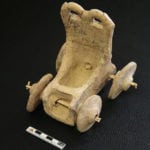 Weird Stuff
Weird Stuff  Weird Stuff
Weird Stuff  History
History 10 Legends Whose Last Moments Undid Their Glory
 Health
Health 10 Futuristic Ideas to Treat Common Medical Problems
 Weird Stuff
Weird Stuff Ten Surreal Attempts to Reverse Baldness
 Facts
Facts 10 U.S. Government Contingency Plans for the Unthinkable
 History
History 10 Weird Distractions from the Great Depression
 Movies and TV
Movies and TV 10 Fictional Kings Who Go from Good to Bad
 Food
Food The Fantastic Chemistry Behind Why 10 Popular Foods Taste So Good
 Technology
Technology 10 Futuristic Fungal Technologies
 History
History 10 Not-so-Spooky Events That Also Happened on October 31
 Weird Stuff
Weird Stuff 10 Things So Rare They’ve Only Been Found Once
 History
History 10 Legends Whose Last Moments Undid Their Glory
 Health
Health 10 Futuristic Ideas to Treat Common Medical Problems
Who's Behind Listverse?

Jamie Frater
Head Editor
Jamie founded Listverse due to an insatiable desire to share fascinating, obscure, and bizarre facts. He has been a guest speaker on numerous national radio and television stations and is a five time published author.
More About Us Weird Stuff
Weird Stuff Ten Surreal Attempts to Reverse Baldness
 Facts
Facts 10 U.S. Government Contingency Plans for the Unthinkable
 History
History 10 Weird Distractions from the Great Depression
 Movies and TV
Movies and TV 10 Fictional Kings Who Go from Good to Bad
 Food
Food The Fantastic Chemistry Behind Why 10 Popular Foods Taste So Good
 Technology
Technology 10 Futuristic Fungal Technologies
 History
History 10 Not-so-Spooky Events That Also Happened on October 31
10 Amazing Astronomical Relics
In spite of astrology, the ancients accumulated a surprisingly large body of astronomical knowledge. This age-old love of stars bridges time and space. Most importantly, it reminds us of just how little we are.
10 Babylonian Jupiter Tablet
The ancient Babylonian people in what is now modern-day Iraq obsessed over the stars long before the birth of Christ. A set of ancient tablets from the early centuries BC have revealed planetary math that was previously credited to 14th-century Europeans.
The Babylonians followed heavenly bodies across the sky and appointed them as prognosticators of Earthly events, birthing “modern” astrology and the 12 zodiacal signs.
They also tracked Jupiter with beautiful precision, yet it took a good deal of detective work to figure it out. For some time, lead researcher Mathieu Ossendrijver poured over four mysterious cuneiform tablets that bore no direct mention of mighty Jupiter.
Instead, the tablets prattled on about an arcane branch of trapezoidal mathematics. Ossendrijver believed that the data might be astronomical in nature. It just felt spacey, but he was otherwise stumped.
In 2014, a colleague sent him a photograph of a fifth tablet. When Ossendrijver translated the image, he found that it detailed a geometric calculation of Jovian motion.
The tablets recorded Jupiter’s movements across time to ascertain the distance traveled by our most prominent gas giant. It’s an ancient position versus time graph that was used for the serious business of predicting fruitful harvests and other agricultural milestones.
9 Buena Vista

Buena Vista, the western hemisphere’s oldest observatory, is tucked away in the Peruvian Andes several miles from Lima. At 4,200 years old, it predates the Incan civilization by a whopping 3,000 years. It also predates fire-hardened pottery. It’s so aged that archaeologists can’t even identify its Andean creators—only that they were 800 years ahead of the curve.
Thankfully, the observatory’s collection of temples and carvings emerged from the ground mostly intact and untouched by tomb raiders—though just barely. Looters did attempt entry into the site but gave up several inches too soon.
Since the original builders preferred to keep their grandest creations in mint condition, they carefully buried the site 6 meters (20 ft) deep while it was still fresh. Considering that the region is virtually free of rain, it was a perfect storm of preservation.
Buena Vista is spread over 20 barren acres of hilltop property. The observatory itself is perched atop a pyramid measuring 10 meters (33 ft) in height. Apparently, Buena Vista was used as a celestial agricultural calendar, marking the summer solstice planting period and the winter solstice harvest.
In addition to a monolithic frowning face, animal carvings decorate the complex, including culturally ubiquitous llamas as well as foxes. Legend has it that these animals taught indigenous peoples the art of farming.
8 Astronomical Wine Cup
Astronomical inscriptions have turned up in all sorts of unexpected places, including ancient drinking vessels. A 2,600-year-old skyphos (double-handled cup) was pulled from a ditch at the Halai acropolis outside Thebes and seems to combine the two traditional Greek pastimes of stargazing and drinking.
The wine cup depicts a seemingly random zoological mishmash. On it, we see a bull, a snake, a large feral cat (possibly a lion or panther), a scorpion, a hare-dog creature, and most unexpectedly, a dolphin. At first glance, the cup displays the common motif of a hunting scene. However, that blasted dolphin voids this hypothesis.
Instead, University of Missouri researchers posit that the animals represent constellations. The relative positions are inaccurate but only because ancient artisans organized the constellations by season and not their placement in the night sky.
The discovery opens up the exciting possibility that other astronomical depictions have gone unnoticed in plain sight—just as the cup itself languished in obscurity at the Lamia Archaeological Museum in Greece.
7 Valle dei Templi Alignments
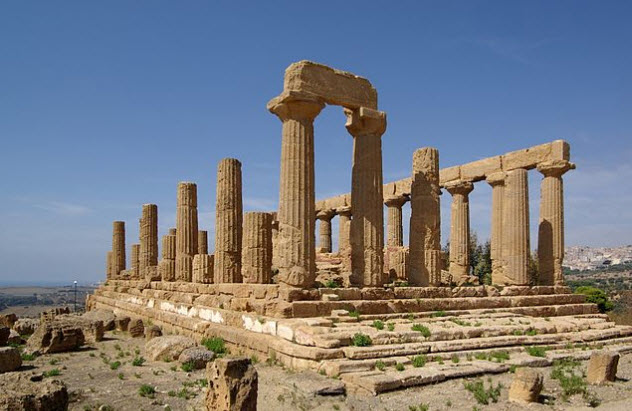
The Valle dei Templi (“Valley of the Temples”) is a UNESCO World Heritage Site and an Italian national monument at Agrigento, Sicily. It contains the remains of 10 grand Doric shrines and temples, all devoted to superstar Greek heroes and gods. One is an earthquake-and-battle-damaged monument dedicated to big boss Zeus—the largest Doric temple ever constructed.
Previously, archaeologists had assumed that the ancients built the sites according to cosmic orientations such as sunrises and moonrises on certain dates. But a collaboration of Italian and New Zealander scientists has partially quashed the hypothesis. While some of the temples are indeed aligned to face cosmic bodies, not all of them are.
Some of the temples have their facades facing the eastern horizon as per tradition. However, this is based not on celestial considerations but on urban planning and adherence to cardinal points. For example, the mighty temple of Zeus was aligned with the street grid and not the heavens.
However, some shrines are oriented toward the sky. The temple of Demeter and Persephone faces the full Moon during the winter solstice. Similarly, the temple of Juno faces the constellation Delphinus.
Was this on purpose? Surprisingly, the ancients were unusually tight-lipped about these constructions, and archaeologists have been unable to find any written explanations.
6 Cheomseongdae
Cheomseongdae is a star-watching tower in South Korea. Commissioned during the Silla dynasty by Queen Seondeok, the milk bottle–shaped structure dates back to 647 AD, shortly after the sovereign’s death. It is Asia’s oldest astronomical observatory.
The outpost is 9 meters (30 ft) high and cobbled from 365 fabricated granite slabs, apparently one for each day of the solar year. However, some sources claim that there are only 362 stones.
The tower is split into 27 levels, a nod to its ancient parent who was the Silla dynasty’s 27th head of state. Of these levels, 12 are situated below a central window and 12 above. This positioning represents the months as well as the 12 major and 12 minor solar terms, which are believed to correspond to natural phenomena.
Cheomseongdae represents an admixture of scientific and pseudoscientific knowledge. Royal astronomers and astrologers charted the movement of heavenly bodies and recorded cosmic phenomena.
However, they used this arcane knowledge to foretell the weather, predict social events, influence political as well as agricultural decisions, and portend war.
It was also believed that a child’s destiny was apparent in the stars, so astrologers composed various astrological formulas to ascertain future merit. To their credit, Korean stargazers also predicted eclipses and charted the paths of comets.
5 Desert Glass
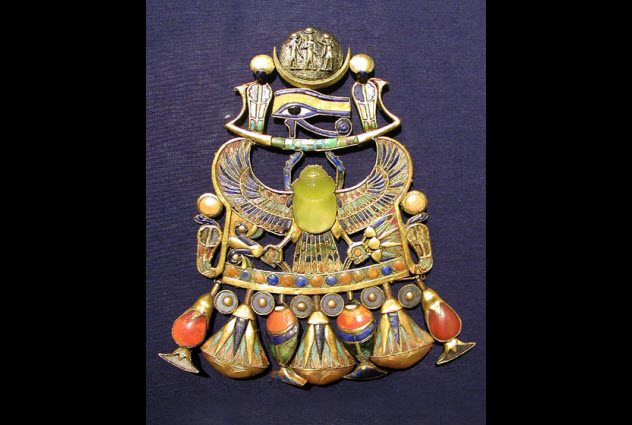
Around 29 million years ago, a meteorite either impacted or exploded somewhere along the Egyptian-Libyan border. Temperatures at the blast site soared to 1,600 degrees Celsius (2,900 °F). The tremendous force launched significant quantities of molten sand into the air, which solidified and rained down as glass.
This Libyan desert glass ranges from white to a phlegmy yellow-green and has a gemlike sheen. The finest pieces are smoothly translucent with pseudo regmaglypts (thumbprint-like impressions). The ancient Egyptians revered the material as “the rock of God,” thinking so highly of it that King Tut’s funerary pendant featured a desert glass scarab as its centerpiece.
Archaeologists discovered the gorgeously detailed amulet-necklace in the early 1920s while surveying Tutankhamun’s tomb. The necklace is dripping with Egyptian imagery, including the protective Eye of Horus and a scarab, the symbol of regeneration, to ensure a fruitful afterlife for the boy-pharaoh. However, its extraterrestrial origin was only revealed after chemical analyses were conducted in 1999.
4 The Shadow Serpent
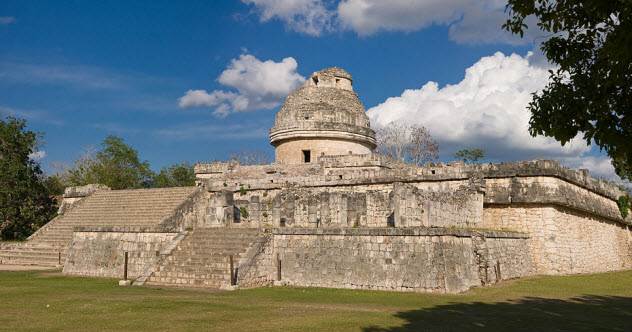
In part, the Mayan city Chichen Itza was built to receive heavenly visitors. Its most iconic site is a step pyramid dedicated to Kukulkan (aka Quetzalcoatl), the feathered serpent god that descends upon the place twice a year from its cosmic perch.
Thousands of tourists flock to the pyramid, known as El Castillo, for a biannual light show that occurs during the autumnal and vernal equinoxes. At that time, the setting Sun sends an oscillating shadow down the steps like a massive snake—Kukulkan paying his charges a visit. For seven hours, the shadow gradually descends across the pyramid before uniting with a set of carved snakeheads at its base.
The play of light is almost certainly deliberate, and El Castillo may have doubled as an observatory. Its four grand staircases represent the seasons and contain 91 steps each. An additional step at the top completes the cycle of 365 solar days, so it’s entirely possible that the structure was used to track the Sun cycle.
Chichen Itza also features a cylindrical structure that closely resembles modern observatories. El Caracol (“The Snail”), which is named for its spiraling staircases, rises above the surrounding vegetation to provide an unobstructed view of the stars.
Although the structure is severely degraded, three narrow slits have survived to hint at its purpose. Apparently, El Caracol tracked Venus across the sky, and these small windows allowed a view of the planet rising at its northern and southern extremes.
3 Hevelius’s Awesomely Illustrated Charts
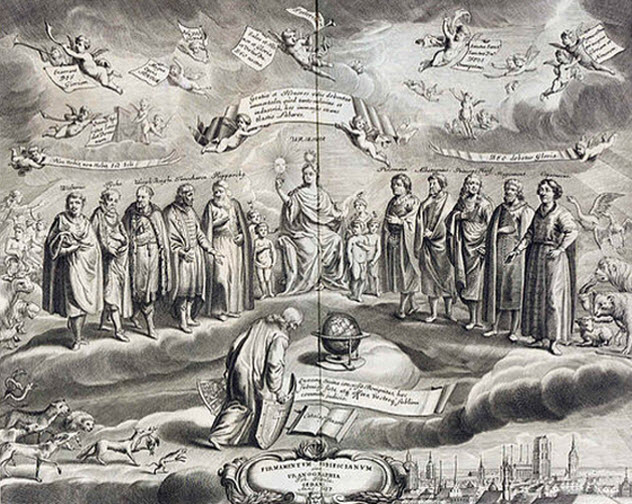
Self-made Polish astronomer Johannes Hevelius used handcrafted astronomical tools to chart the heavens. He transformed this data into the Firmamentum Sobiescianum sive Uranographia, a collection of 56 double-paged, expertly illustrated star maps published in 1690.
In his atlas, Hevelius debuted 11 brand-new constellations, seven of which are still recognized today. The other four have merged with other constellations.
His celestial atlas was also the first to accurately depict the southern stars. Hevelius integrated the observations made by Edmond Halley when the comet’s namesake traveled to St. Helena in 1676 to chronicle the southern skies.
In these early days, astronomy, art, and lore were inseparable as is evident on the front cover of Hevelius’s revolutionary sidereal document. Hevelius holds a sextant and an engraved shield, which represents the newly discovered constellation Scutum.
Bowing, Hevelius offers his knowledge to a panel of cosmic judges, including Hipparchus, Tycho, Ptolemy, and Urania, the muse of astronomy. Hevelius is also accompanied by a menagerie of animals, the incarnate forms of his constellations.
2 Iron Man Meteorite Statue
The Tibetan “Iron Man” statue is exquisitely carved from a meteorite. In 1938, the beefy 10-kilogram (22 lb) sculpture was recovered by a Nazi survey. The statue sports a Buddhist bent-armed cross on its upper abdomen, a symbol adopted by the SS as the Nazi swastika.
Iron Man was rich in nickel and cobalt, and a chemical analysis confirmed the celestial origins of these elements. The statue was fabricated from ataxites, the rarest of all meteorites, which comprise only 0.1 percent of space rocks.
This particular ataxite crash-landed somewhere in the greater Siberia-Mongolia area around 15,000 years ago and was transformed into the only human likeness ever hewn from a cosmic source, exponentially raising the relic’s rarity. One archaeologist has appraised it, conservatively, at around $20,000.
However, its age is unconfirmed. Some researchers believe that it is at least 1,000 years old, although others contend that its features are not consistent with 11th-century Buddhist statues.
They argue that it has a 20th-century birthdate because of its Western footwear, anachronistic trousers, and uncharacteristically bushy beard. Even if it was manufactured between 1910 and 1970, as some claim, it’s arguably just as fascinating for its otherworldly origin.
1 Egyptian Algol Papyrus
The overachieving Egyptians can now add another feather to their cap. A raggedy piece of papyrus known as Cairo 86637 has recently been recognized as the most ancient record of a variable star, besting the previous oldest document by several thousand years.
Dated between 1244 BC and 1163 BC, it tracks the dimming and flaring of Algol, the Arabic-named demon star that represents Medusa’s slithering visage. Algol is part of a binary system shared with its brighter brother, Mirfak.
Together, they form a small part of the constellation Perseus, which is named after the legendary Greek hero and dynasty starter who beheaded the Gorgon Medusa and cleverly used her severed stare to petrify the trash-talking sea monster Cetus.
Algol must have stood out to Egyptian astronomers like a sore thumb. It’s an eclipse-happy binary system that we have the privilege of viewing nearly edge-on from Earth.
As a result, Algol’s brightness can vary threefold. This cycle lasts two days, 20 hours, and 49 minutes. The 3,000-year-old papyrus offers a similar figure of 2.85 days.
The period observed today is 2.87 days, suggesting an increase due to mass transfer between the stars. This is the first evidence of Algol’s shifting period. Based on this increase, astronomers can also deduct the amount of mass shared. It’s even possible that the Persei system could be upgraded to three stars.
The papyrus is also known as the Cairo Calendar because it used the periods of Algol as well as the Moon (29.6 days) to predict a person’s fortune. Each day was split into three parts, and the celestial alignments supposedly foretold of good or bad events to take place during each.




